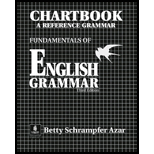

ix Degrees of Teacher and Student Involvement. Suggestions for Presenting the Grammar Charts. ix General Aims of Fundamentals of English Grammar. Azar Associates Shelley Hartle, Editor Susan Van Etten, Manager Pearson Education, 10 Bank Street, White Plains, NY 10606 Vice president of instructional design: Allen Ascher Editorial manager: Pam Fishman Project manager: Margo Grant Development editor: Janet Johnston Vice president, director of design and production: Rhea Banker Director of electronic production: Aliza Greenblatt Executive managing editor: Linda Moser Production manager: Ray Keating Production editor: Robert Ruvo Director of manufacturing: Patrice Fraccio Senior manufacturing buyer: Edie Pullman Cover design: Monika Popowitz Text composition: Carlisle Communications, Ltd. No part of this publication may be reproduced, stored in a retrieval system, or transmitted in any form or by any means, electronic, mechanical, photocopying, recording, or otherwise, without the prior permission of the publisher. Matthies Shelley Hartleįundamentals of English Grammar, Third Edition Teacher’s Guide Copyright © 2003, 1992, 1985 by Betty Schrampfer Azar All rights reserved. 246 Using the same, similar, different, like, alike. 233 Comparative and superlative forms of adjectives and adverbs. 221 Connecting ideas with even though/although. 200 Making suggestions: let's and why don't. 199 Giving instructions: imperative sentences. 197 Tag questions with modal auxiliaries. 193 Expressing lack of necessity: do not have to Expressing prohibition: must not. 191 Expressing necessity: have to, have got to, must.


189 Expressing advice: should and ought to. Polite questions: would you, could you, will you, can you. 184 7-5 Polite questions: may I, could I, can I. 182 7-4 Using could to express possibility. 180 7-3 Expressing possibility: may, might, and maybe Expressing permission: may and can. 178 7-2 Expressing ability: can and could.

171 6-15 Plural forms of other: other(s) vs.the other(s). 169 6-14 Singular forms of other: another vs. 166 6-12 Possessive pronouns and adjectives. 162 6-10 Personal pronouns: subjects and objects. 158 6-8 Using adjectives to describe nouns. 13 7 5-14 Using how about and what about. 132 5-12 Spoken and written contractions with question words. 131 5-11 Length of time: it+ take and how long. 117 5-4 Questions with who, who(m), and what. 114 5-3 Where, why, when, what time, how come, what. 111 5-2 Yes/no and information questions. 111 5-1 Yes/no questions and short answers. 98 Present perfect progressive vs.present perfect. 87 Present perfect with unspecified time. Negative, question, and short-answer forms. 81 4-2 Present perfect with since and/or. 74 3-9 Immediate future: using be about to. 72 3-8 Using the simple present to express future time. 68 3-7 Using the present progressive to express future time. 65 3-6 Expressing the future in time clauses and if-clauses. 55 3-1 Expressing future time: be going to and will. 42 2-7 Expressing past time: using time clauses. 32 2-5 Regular verbs: pronunciation of -ed endings. 31 2-4 Common irregular verbs: a reference list. 26 2-1 Expressing past time: the simple past. 17 1-7 Present verbs: short answers to yes/no questions. 3 1-2 Forms of the simple present and the present progressive. l 1-1 Simple present and present progressive.


 0 kommentar(er)
0 kommentar(er)
